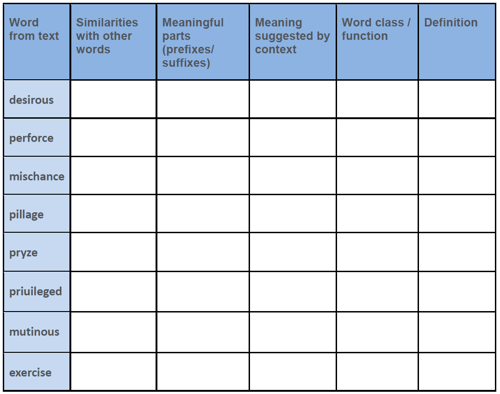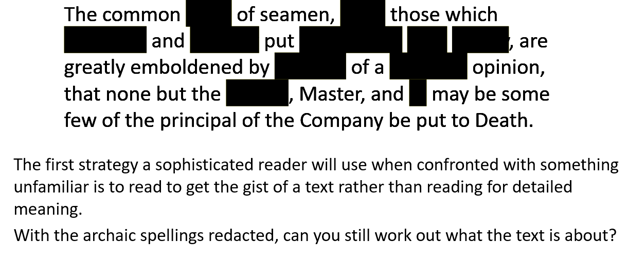
Reading Resilience
In this blog Kirsten Wilcock, subject officer for GCE English Language, explores the concept of reading resilience and ways it might be developed.
Reading resilience has been the subject of many an academic research project, but how does this impact on the classroom? Whilst working as a consultant with 60 different schools, introducing strategies for developing reading resilience became a common thread as it is a universal issue: wherever students are presented with reading material, they are confronted with the possibility of ‘the unfamiliar’.
This was something I was acutely aware of as an inexperienced teacher of English, given the F/G GCSE class. By the time I had gone around the fifteen of them in the class handing out the carefully chosen text for our exam preparation that lesson, the first three had already scrunched up the paper and cast it aside, claiming that they couldn’t understand the text. They had started reading and stopped at the fourth word, which they didn’t know. This was enough for them to give up on all understanding.
This is very often what happens when students encounter words, constructs or concepts that are unfamiliar to them if they do not have strategies to consciously apply to make meaning. This is just as relevant for a Year 7 French class looking at a French tourism website as a Year 13 A level English Language group studying Early Modern English.
So, what do we mean by ‘reading resilience’, and is this different to ‘reading stamina’? both are important skills for students to have but there are more strategies that can be practised and perfected with students to improve their reading resilience. Reading stamina is a student’s ability to focus and read independently for long periods of time without being distracted or distracting others. Reading resilience is a student’s ability to read and interpret complex and demanding texts, both continuous and non-continuous, by drawing on advanced, engaged, critical reading skills.
If we want to reach the point where students are automatically and autonomously managing complex and demanding texts, we must believe that by teaching strategies we develop skills. Strategies are used deliberately and consciously until the point they become skills and are embedded in the student’s way of working.
For KS3 and KS4 students there are plenty of online resources, particularly graphic organisers, to support the use of reading strategies. In developing reading resilience some of the more practical approaches include (some examples in the appendix):
- dissecting the text: read the word; re-read the word; consider the context; ‘chunk’ the word into meaningful parts (syllables, prefix, suffix, base word); compare the word with other, similar, familiar words; check with the dictionary.
- redacting unfamiliar vocabulary – can meaning still be found? Getting the gist.
- KW(H)L grids
- understanding word classes and function
- identifying and using context clues: purpose, genre, audience
- making predictions based on prior knowledge about the vocabulary, style, structure
- teacher modelling of the cognitive behaviours of effective readers
- metacognitive questioning.
Much of the research on strategies for developing reading resilience skills highlight the impact of metacognitive questioning, modelled first by the teacher, moving to scaffolding for the student to pose the questions before finally the student assimilating such questioning into their reading processes. Often, metacognitive questions are categorised as before, during and after reading for ease of use. Examples are given in the appendix.
The impact of explicit metacognitive questioning is that is promotes active thinking and the use of reading strategies that ‘upskill’ students to access meaning in texts that they consider difficult.
There are many other pre-, during and after reading strategies that can be used with students of all ages.
Pre-reading activities
- activating students’ prior knowledge about characteristics of different texts: good readers expect to understand what they are reading from the early clues such as connections with other writers/texts, knowledge of genre, context, layout, understanding of textual features, etc.
- understanding the layout of the material being read in order to focus more deeply on the parts that contain information. What could prior knowledge of the conventions of particularly text types add to a student’s understanding?
- exploring the purpose for the reading by encouraging students to ask themselves: "Why am I reading this text? What do I want to know or do after reading?" For example, locating specific information or understanding an explanation.
- identifying specific reading approaches for different purposes: skimming for reading rapidly for the main points (e.g. identifying topic sentences); scanning for reading rapidly to find a specific piece of information (answering a retrieval question); extensive reading for reading a longer text with emphasis on overall meaning; or intensive reading for reading a short text for detailed information.
- Working at word level using knowledge of word meaning; word identification strategies; and finding synonyms, antonyms, derivatives, or associated words.
During-reading activities
- predicting what is going to happen next in the text by being alert to what has come and integrate with what is to come.
- using prior knowledge to confirm / contradict expectations of text.
- skipping insignificant parts: by linking with the understanding of the purpose of their reading, a good reader will concentrate on significant pieces of information while skipping insignificant pieces.
- re-reading: by recognising where there isn’t full understanding, readers should return to specific parts of the text.
- making use of context / guessing: it’s not necessary to define and understand every unfamiliar word in a text: make use of context to start working out the meaning of unknown words.
- breaking words into their component parts: efficient readers break words into their affixes, prefixes and suffixes, which can help readers work out the meaning of a word.
- pausing: good readers will pause at certain places while reading a text to absorb and internalise the material being read and sort out information.
- reflecting on their reading: is meeting their goals/purpose?
After-reading activities
These will depend on the purpose of reading and the type of information extracted from the text but will check students' understanding and then direct them to a deeper analysis of the text. Group discussion on the meaning of the text will help students focus on information they did not understand or misunderstood.
Hopefully, in employing reading strategies that then becoming embedded, automatic reading skills, we can develop a generation of readers who are not afraid of the unfamiliar.
Further reading:
Clarifying Differences Between Reading Skills and Reading Strategies, Peter Afflerbach, P. David Pearson, Scott G. Paris
Reading and Resilience, Alfred W. Tatum
| Appendix |
|
1. Dissecting the text
|
|
2. Redacting unfamiliar vocabulary
|
|
3. KW(H)L grids
|
|
4. Metacognitive questioning Pre-Reading Metacognitive Questions
During Reading Metacognitive Questions
During Reading Metacognitive Questions
|


